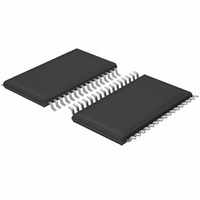UDA1380TT/N2,512 NXP Semiconductors, UDA1380TT/N2,512 Datasheet - Page 15

UDA1380TT/N2,512
Manufacturer Part Number
UDA1380TT/N2,512
Description
IC AUDIO CODER-DECODER 32-TSSOP
Manufacturer
NXP Semiconductors
Type
Stereo Audior
Datasheet
1.UDA1380HNN2118.pdf
(68 pages)
Specifications of UDA1380TT/N2,512
Package / Case
32-TSSOP
Data Interface
I²C, Serial
Resolution (bits)
24 b
Number Of Adcs / Dacs
2 / 2
Sigma Delta
No
S/n Ratio, Adcs / Dacs (db) Typ
97 / 100
Voltage - Supply, Analog
2.4 V ~ 3.6 V
Voltage - Supply, Digital
2.4 V ~ 3.6 V
Operating Temperature
-40°C ~ 85°C
Mounting Type
Surface Mount
Interface Type
Serial (I2C)
Resolution
24 bit
Operating Supply Voltage
3 V
Maximum Operating Temperature
+ 85 C
Mounting Style
SMD/SMT
Minimum Operating Temperature
- 40 C
Supply Current
10 mA
Thd Plus Noise
- 85 dB
Lead Free Status / RoHS Status
Lead free / RoHS Compliant
Other names
935270659512
UDA1380TT
UDA1380TT
UDA1380TT
UDA1380TT
NXP Semiconductors
8.4
The interpolation digital filter interpolates from 1 to 64f
to 128f
interpolator is equipped with several sound features like
volume control, mute, de-emphasis and tone control.
Table 4 Interpolation filter characteristics
8.4.1
Muting the DAC will result in a cosine roll-off soft mute,
using 4 × 32 = 128 samples in normal mode (or 3 ms at
44.1 kHz sampling frequency). The cosine roll-off curve is
illustrated in Fig.8. These cosine roll-off functions are
implemented for both the digital mixer and the master mute
inside the DAC data path, see Section 8.8.
2004 Apr 22
Pass-band ripple
Stop band
Dynamic range
handbook, halfpage
Stereo audio coder-decoder
for MD, CD and MP3
Fig.8
factor
mute
0.8
0.6
0.4
0.2
s
Interpolation filter (DAC)
, by cascading FIR filters, see Table 4. The
ITEM
1
0
DIGITAL MUTE
0
Mute as a function of raised cosine roll-off,
displayed assuming 44.1 kHz.
5
0 to 0.45f
>0.55f
0 to 0.45f
CONDITION
10
s
s
s
15
20
±0.025
−60
>135
VALUE (dB)
t (ms)
MGU119
25
s
or
15
8.4.2
In addition, there are basic sound features:
• dB-linear volume control using 14-bit coefficients in
• De-emphasis for 32, 44.1, 48 and 96 kHz for both
• Treble, which is selectable gain for high frequencies
• Bass boost, which is selectable gain for low frequencies
8.5
The noise shaper consists of two mono 3rd-order noise
shapers and one time-multiplexed stereo 5th-order noise
shaper.
The order of the noise shaper can be chosen between
3rd-order (which runs at 128f
at 64f
The preferable choice for the noise shaper order is:
• 3rd-order noise shaper is preferred at low sampling
• 5th-order noise shaper is normally used at higher
The noise shaper shifts in-band quantization noise to
frequencies well above the audio band. This noise shaping
technique enables high signal-to-noise ratios to be
achieved. The noise shaper output is converted into an
analog signal using an FSDAC.
steps of 0.25 dB: range 0 to −78 dB maximum
suppression and −∞ dB: applies to both master volume
and mixing volume control
channel 1 and 2 (selectable independently)
(positive gain only), the edge frequency of the treble is
fixed (depends on the sampling frequency). Can be set
for left and right independently:
– Two settings: f
– Both settings have 0 to 6 dB gain range in steps
(positive gain only). The edge frequency of the bass
boost is fixed and depends on the sampling frequency.
Can be set for left and right independently:
– Two settings: f
– First setting: 0 to 18 dB gain range in steps of 2 dB
– Second setting: 0 to 24 dB gain range in steps
frequencies, for instance between 8 and 32 kHz. This is
for preventing out-of-band noise from the noise shaper
to move into the audio band
sampling frequencies, normally from 32 to 100 kHz.
sampling frequency is 44.1 kHz
of 2 dB
sampling frequency is 44.1 kHz
of 2 dB.
s
) via bit SEL_NS in the L3-bus or I
Noise shaper
S
OUND FEATURES
c
c
= 250 Hz and f
= 1.5 kHz and f
s
) and 5th-order (which runs
c
c
Product specification
= 300 Hz, assuming
= 3 kHz, assuming
UDA1380
2
C-bus register.















